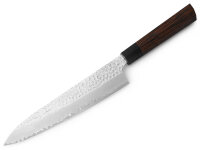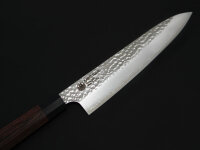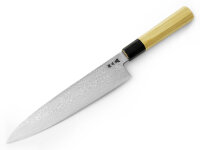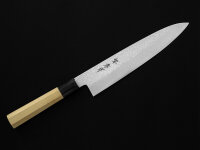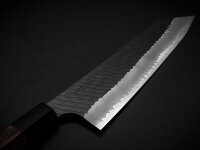
Japanese Gyuto Knives
The Japanese Gyuto Knife
Gyuto is a Japanese knife style that is not as well-known as the Santoku knife, even though it is one of the most important kitchen knives in both professional and home kitchens. The Japanese Gyuto chef's knife, double-edged, is essentially equivalent to what we call a chef's knife in the West and is used for a wide range of tasks. The term Gyuto refers to the knife's blade length and its intended uses. The main differences from Western chef's knives: Japanese Gyuto knives are characterized by their thinner blade, a much smaller angle from the knife's spine to the cutting edge, lower weight, higher hardness, and sharpness.
The Gyuto knife is, in essence, the Japanese chef's knife and is fundamentally a contender for the title of "Best Chef's Knife in the World." The blade lengths of these double-edged knives range approximately from 180mm to 280mm, with most Gyuto knives having blade lengths of 210mm or 240mm. The thickness of the blades of high-quality hand-forged Gyuto knives varies depending on the design, ranging from about 3mm to 1.7mm near the handle and 1.7mm to 1.5mm near the tip. The thinnest knife blades are found in Gyuto Damascus knives because master smiths can forge Japanese Damascus knives with high durability but less material, despite the considerable length of the blades.
The Gyuto chef's knife is, alongside the Santoku knife, the most versatile knife in the kitchen. In Western kitchens, it is also referred to as the chef's knife, although this knife certainly brings joy and ease of work not only to kitchen chefs. Those who are reconsidering or rebuilding their kitchen knife repertoire and are considering Japanese knives will most likely conclude that the Japanese Gyuto knife should be included. Japanese Gyuto knives have a relatively slim shape, with the cutting line featuring a slight curve towards the tip. Japanese Gyuto knives excel at tasks that require high precision, particularly with the front part of the blade.
Gyuto Chef's Knife, the Japanese Knife for Meat, Fish, and Vegetables
Often, the chef's knife is reduced to the term "meat knife," which doesn't do it justice. On the contrary, in professional kitchens, the chef's knife is the primary knife, which is why it's called the chef's knife. Japanese chefs use the Gyuto chef's knife for meat, fish, fruits, and vegetables. What determines whether the Gyuto knife is used or a specialized knife is the cutting technique, not the type of food being cut. Whenever a clean, smooth cut from top to bottom is desired for a larger piece, both Japanese and Western professionals prefer to use the Gyuto knife. But even for filleting and carving, the Gyuto chef's knife excels. So, there are many tasks in the kitchen for the sharp Japanese Gyuto chef's knife, and it brings a lot of joy to work with this excellent Japanese kitchen knife, both for Japanese and European chefs.
Blade Length: How Long Should the Gyuto Knife Be?
We offer the Japanese Gyuto knife with blade lengths of 180mm, 210mm, and 240mm. There are Gyuto chef's knives available in the market with blade lengths of up to 280mm. The usefulness of such a long blade length for a multipurpose knife can be questioned. A blade that is too long tends to limit the versatility of the knife, and a Gyuto with a 280mm blade still cannot match the outstanding, specialized abilities of a Sashimi or Yanagiba knife, which are specialized filleting knives. Therefore, if your goal is to acquire a new knife with the broadest range of uses, you will most likely be better off with a slightly more modest blade length. The range of blade lengths between 180mm and 240mm, based on our experience, practically fulfills all individual preferences. Of course, the choice of the right blade length also depends on your own height and personal experience. However, regardless of blade length, one thing of great importance is that the Gyuto chef's knife, like all good kitchen knives, must be well-balanced. This is a quality criterion that Japanese manufacturers of high-quality hand-forged chef's knives place great emphasis on.
What to Consider Before Buying a Gyuto Chef's Knife
Which Japanese Gyuto knife is the best? In addition to the usual quality criteria, in our opinion, it particularly depends on these points:
- Sharpness: The sharpness potential of the steel used should be as high as possible. High-quality Japanese Gyuto knives, especially hand-forged Japanese knives, are made from steels that are much harder than European knife steels. Hardness levels of 60 to 67 HRC, combined with a very well-crafted blade, provide the highest sharpness potential in the realm of kitchen knives. At the same time, these steels also offer edge retention that is significantly higher than that of European stainless steel, meaning these knives stay sharp noticeably longer.
- Balance: The knife should be well-balanced. Experienced knife smiths, whose chef's knives are particularly popular among professional chefs in Japan as well as in Europe, pay very close attention to ensuring their knives are well-balanced. The balance of a knife is of enormous importance, especially for users who work extensively and rapidly with the chef's knife.
- Blade Length: A professional chef has a lot of practice using their Gyuto chef's knife, as they work with it for many hours every day. In a home kitchen, the Gyuto chef's knife is used frequently but for shorter periods. As previously mentioned, excessive length can limit versatility.
- Finish: The right Gyuto chef's knife is very sharp, well-balanced, and has a sufficiently long but not overly long blade. The finish of the blade of a Japanese Gyuto knife brings additional advantages compared to a Western stainless steel knife: those who want to cut fine slices or fillets will appreciate it when the finish has an anti-stick effect. For a very fast-working professional chef, this is a significant advantage, but even every home cook will quickly come to appreciate this feature, especially when cutting vegetables. To counter this phenomenon, some chef's knives have a hollow ground or a granton edge. However, these "anti-stick measures" often weaken the blade. Hand-forged kitchen knives from Japan address this issue with a blade finish such as a hammered finish, a bronzed blade, a Kuroshiage, or a Pearl Skin (Nashiji) finish. All these kitchen knife surfaces have a highly effective anti-stick effect.
- Craftsmanship: Buying cheap often means buying twice. Hand-forged knives should come from experienced smiths. For example, Kanehiro was founded in 1914 and is now in its third generation of being master smiths of Japanese chef's knives. Japanese smiths must undergo a long apprenticeship before they can be called masters and forge their own knife series. Yoshimi's father, Hiroshi Kato, has been making knives for 60 years, learning his art from his father and passing down his experience and skills to his son.
Safe Cutting
First, it is worth relativizing the fear of sharp knives. Most cutting accidents do not occur with sharp knives but with dull or the wrong knives. The Gyuto chef's knife is typically used in the front third of the blade and is used in a circular motion from top to bottom and away from the body. The slightly longer blade, compared to the Santoku knife, is very useful for this motion. If you haven't practiced this movement correctly yet, it may take some training, but it won't take long before you've mastered it. The sharper the knife, the easier it is to cut slices with this single movement. Proper hand positioning is, of course, also important. The hand holding the knife should have a secure grip on the Gyuto chef's knife. The fingers of the other hand are used to guide the blade in a way that the front finger joints are bent. The thumb should rest firmly behind the knife against the cutting material, helping to secure and transport it forward.
Gyuto Chef's Knives at Oryoki
Oryoki offers the following chef's knives for the preparation of fish, meat, fruits, and vegetables:
- Gyuto Damascus Knife Yoshimi Kato, 63 Layers, Olive: 63 layers, blade length approx. 21 cm, sharpened on both sides, weight approx. 140 g. A very good Japanese Gyuto from master blacksmith Yoshimi Kato, Kanehiro with a beautiful olive wood handle. Hand-forged from SG2/SPG2 steel. The blade hardness is about 63 HRC.
- Gyuto Knife 240, Yoshimi Kato Nashiji: 3 layers, blade length approx. 24 cm, double-edged, weight approx. 195 g. This Gyuto is also forged by Yoshimi Kato from Aogami Super. However, the longer blade features a rust-resistant Nashiji finish, also known as Pear Skin, which is simultaneously non-stick.
- Damascus Gyuto Knife 210, Yoshimi Kato Kurosome: 30 layers, blade length approx. 22 cm, double-edged, weight only 135 g. This beautiful, cold-forged Damascus knife by Yoshimi Kato is rust-resistant bronzed. The fantastic, very sharp blade is only about 1.6 mm thick. The VG-10 stainless steel is hardened to 61 - 62 HRC.
- Gyuto Damascus Knife, Kuroshiage Nami: 16 layers, blade length approx. 21 cm, double-edged, weight approx. 155 g. An impressive knife with an unusual appearance. 16 layers of Damascus, black forged (Kuroshiage). The knife is made from white paper steel, Shirogami, with a very high carbon content. Hard and sharp. Forged at 61 - 62 HRC and sharpened by Shibata Takayuki, a master of his craft.
- SPG2 Kuroshiage Tsuchime Kiritsuke Gyuto : Kuroshiage Hammering, blade length approx. 24 cm, double-edged, weight approx. 195 g. A very elegant knife. Blade made from Super Powder Gold 2. Hardness approx. 62 - 63 HRC.

